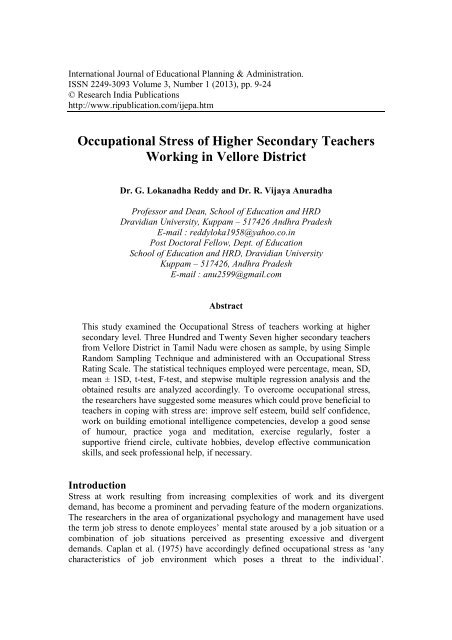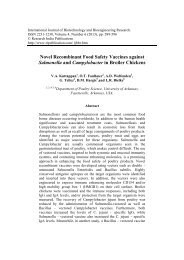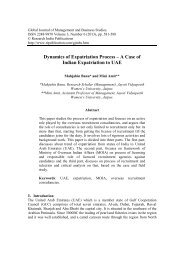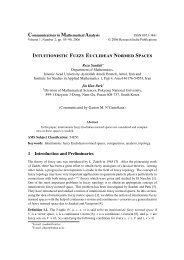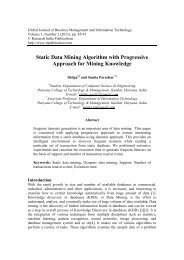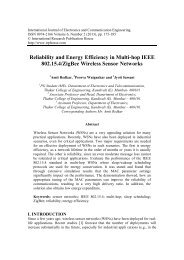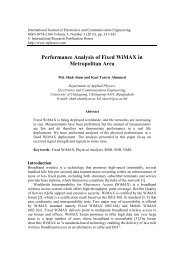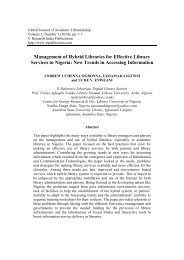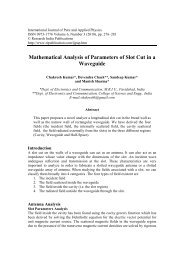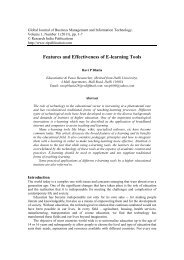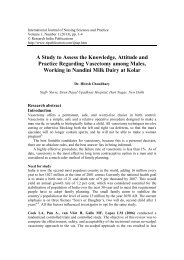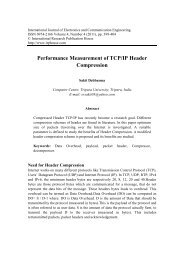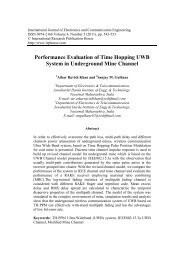Occupational Stress of Higher Secondary Teachers Working in ...
Occupational Stress of Higher Secondary Teachers Working in ...
Occupational Stress of Higher Secondary Teachers Working in ...
Create successful ePaper yourself
Turn your PDF publications into a flip-book with our unique Google optimized e-Paper software.
International Journal <strong>of</strong> Educational Plann<strong>in</strong>g & Adm<strong>in</strong>istration.ISSN 2249-3093 Volume 3, Number 1 (2013), pp. 9-24© Research India Publicationshttp://www.ripublication.com/ijepa.htm<strong>Occupational</strong> <strong>Stress</strong> <strong>of</strong> <strong>Higher</strong> <strong>Secondary</strong> <strong>Teachers</strong><strong>Work<strong>in</strong>g</strong> <strong>in</strong> Vellore DistrictDr. G. Lokanadha Reddy and Dr. R. Vijaya AnuradhaPr<strong>of</strong>essor and Dean, School <strong>of</strong> Education and HRDDravidian University, Kuppam – 517426 Andhra PradeshE-mail : reddyloka1958@yahoo.co.<strong>in</strong>Post Doctoral Fellow, Dept. <strong>of</strong> EducationSchool <strong>of</strong> Education and HRD, Dravidian UniversityKuppam – 517426, Andhra PradeshE-mail : anu2599@gmail.comAbstractThis study exam<strong>in</strong>ed the <strong>Occupational</strong> <strong>Stress</strong> <strong>of</strong> teachers work<strong>in</strong>g at highersecondary level. Three Hundred and Twenty Seven higher secondary teachersfrom Vellore District <strong>in</strong> Tamil Nadu were chosen as sample, by us<strong>in</strong>g SimpleRandom Sampl<strong>in</strong>g Technique and adm<strong>in</strong>istered with an <strong>Occupational</strong> <strong>Stress</strong>Rat<strong>in</strong>g Scale. The statistical techniques employed were percentage, mean, SD,mean ± 1SD, t-test, F-test, and stepwise multiple regression analysis and theobta<strong>in</strong>ed results are analyzed accord<strong>in</strong>gly. To overcome occupational stress,the researchers have suggested some measures which could prove beneficial toteachers <strong>in</strong> cop<strong>in</strong>g with stress are: improve self esteem, build self confidence,work on build<strong>in</strong>g emotional <strong>in</strong>telligence competencies, develop a good sense<strong>of</strong> humour, practice yoga and meditation, exercise regularly, foster asupportive friend circle, cultivate hobbies, develop effective communicationskills, and seek pr<strong>of</strong>essional help, if necessary.Introduction<strong>Stress</strong> at work result<strong>in</strong>g from <strong>in</strong>creas<strong>in</strong>g complexities <strong>of</strong> work and its divergentdemand, has become a prom<strong>in</strong>ent and pervad<strong>in</strong>g feature <strong>of</strong> the modern organizations.The researchers <strong>in</strong> the area <strong>of</strong> organizational psychology and management have usedthe term job stress to denote employees’ mental state aroused by a job situation or acomb<strong>in</strong>ation <strong>of</strong> job situations perceived as present<strong>in</strong>g excessive and divergentdemands. Caplan et al. (1975) have accord<strong>in</strong>gly def<strong>in</strong>ed occupational stress as ‘anycharacteristics <strong>of</strong> job environment which poses a threat to the <strong>in</strong>dividual’.
10 Dr. G. Lokanadha Reddy and Dr. R. Vijaya Anuradha<strong>Occupational</strong> stress, <strong>in</strong> particular, is the <strong>in</strong>ability to cope with the pressures <strong>in</strong> a job(Rees, 1997). It is a mental and physical condition which affects an <strong>in</strong>dividual’sproductivity, effectiveness, personal health and quality <strong>of</strong> work (Comish and Sw<strong>in</strong>dle,1994). The ways <strong>in</strong> which stress manifests itself are generally referred to <strong>in</strong> terms <strong>of</strong>behavioural, physical or psychological outcomes. Teacher stress is a specific type <strong>of</strong>occupational stress. It is the experience by a teacher <strong>of</strong> unpleasant emotions such astension, frustration, anger and depression result<strong>in</strong>g from aspects <strong>of</strong> his/her work as ateacher (Kyriacou, 1987). Overall, teachers manifest<strong>in</strong>g high levels <strong>of</strong> stress alsoshow signs <strong>of</strong> high levels <strong>of</strong> psychological distress, usually demonstrated by highanxiety and low psychological well-be<strong>in</strong>g, as well as decreased job satisfaction i.e.mental ill-health, burnout and job dissatisfaction among the teachers (Traverse andCooper, 1996). <strong>Teachers</strong> form the crux <strong>of</strong> the education system, prepar<strong>in</strong>g the youngadolescents to build their nation with purpose and responsibility and confront thechallenges <strong>of</strong> tomorrow. They are the social eng<strong>in</strong>eers and custodians <strong>of</strong> the futureand it is the responsibility <strong>of</strong> a teacher to mould and shape their future.<strong>Teachers</strong> are perennially exposed to high level <strong>of</strong> stress cutt<strong>in</strong>g across all cultures(Copper and Kelly, 1993; Regl<strong>in</strong> and Reitzammer, 1997; Chan, 1998; Mokdad, 2005).The comb<strong>in</strong>ation <strong>of</strong> long work<strong>in</strong>g hours, <strong>in</strong>sufficient pay, role ambiguity, poorteach<strong>in</strong>g facilities, lack <strong>of</strong> social recognition, poor organizational climate, stra<strong>in</strong>edrelationship with colleagues makeup a stressful recipe. As Kyriacou (1987) po<strong>in</strong>ts out,it is the <strong>in</strong>sidious day to day sources <strong>of</strong> stress with their cumulative effect, and not theless frequent but occasionally <strong>in</strong>tent sources <strong>of</strong> stress, which teachers are concernedwith. The personality variables that have been l<strong>in</strong>ked to stress <strong>in</strong>clude locus <strong>of</strong>control, self-esteem, Type- A behaviour pattern, hard<strong>in</strong>ess and negative affectivity(Ganster and Schaubroeck, 1991b; Murphy, 1995). Demographic variables that areproven to relate to someone’s job stressor/health relationships <strong>in</strong>clude gender, age,marital status, job tenure, job title and hierarchical level (Dua, 1994; Murphy, 1995),among which gender, age and hierarchical level were found to be the most significant,as further explanations reveal.<strong>Stress</strong> is <strong>of</strong>ten accepted as <strong>in</strong>escapable aspect <strong>of</strong> teach<strong>in</strong>g. <strong>Teachers</strong>’ lives areadversely affected by stress lead<strong>in</strong>g to physical ill health (Otto, 1986; Mokdad, 2005)and mental ill health (Fletcher and Payne, 1982; F<strong>in</strong>lay- Jones, 1986; Beer and Beer,1992). Teacher stress <strong>of</strong>ten affects the teacher’s ability to function effectively (Blasé,1986; Poornima, 2010), sometimes to the extent <strong>of</strong> caus<strong>in</strong>g burnout (Seldman andZager, 1998; Reddy, 2011). Other common responses listed by Brown and Ralph(1992) <strong>in</strong>cludes reduction <strong>in</strong> work performance and output; <strong>in</strong>ability to manage timeor delegate; feel<strong>in</strong>gs <strong>of</strong> alienation and <strong>in</strong>adequacy; loss <strong>of</strong> confidence and motivation;<strong>in</strong>creas<strong>in</strong>g <strong>in</strong>troversion; irritability with colleagues; unwill<strong>in</strong>gness to cooperate;frequent irrational conflict at work; withdrawal from supportive relationships;<strong>in</strong>appropriate cynical humor; persistent negative thoughts; <strong>in</strong>creased substance abuse;loss <strong>of</strong> appetite; frequent <strong>in</strong>fections; and accident proneness. In the present study, the<strong>in</strong>vestigators made an attempt to assess the level <strong>of</strong> stress experienced by the highersecondary teachers.
<strong>Occupational</strong> <strong>Stress</strong> <strong>of</strong> <strong>Higher</strong> <strong>Secondary</strong> <strong>Teachers</strong> <strong>Work<strong>in</strong>g</strong> <strong>in</strong> Vellore District 11Objectives <strong>of</strong> the Study To develop a tool to assess the level <strong>of</strong> <strong>Occupational</strong> <strong>Stress</strong> <strong>of</strong> higher secondaryteachers. To f<strong>in</strong>d out the significant difference, if any, <strong>in</strong> the <strong>Occupational</strong> <strong>Stress</strong> <strong>of</strong>teachers work<strong>in</strong>g at higher secondary level due to variations <strong>in</strong> their Gender(men / women), Age (up to 35 yrs / 36-45 yrs / 46 yrs and above), Community(OC / BC / MBC, SC & ST), Marital status (married / unmarried), Educationalqualification (PG with B.Ed. & M.Ed. / PG with M.Ed. & M.Phil.), Nature <strong>of</strong>the subject the teachers handl<strong>in</strong>g i.e. Languages (English, Tamil, H<strong>in</strong>di, French)/ Science (Physics, Chemistry, Botany, Zoology) / Mathematics and ComputerScience / Commerce, Salary received (up to Rs.10,000/-, Rs.10,001-Rs 15,000/-,Rs 15,001/-Rs. 20,000/-, Rs.20,001/- and above), Type <strong>of</strong> school they arework<strong>in</strong>g-<strong>in</strong> (government / private), Location <strong>of</strong> school the teachers are work<strong>in</strong>g<strong>in</strong>(rural / urban) and, Years <strong>of</strong> experience ( up to 15 yrs / 16 yrs and above). To study how far and to what extent the <strong>in</strong>dependent variables such as gender,age, community, marital status, educational qualification, nature <strong>of</strong> the subjectsthe teachers handl<strong>in</strong>g, salary they receive, type <strong>of</strong> school they are work<strong>in</strong>g-<strong>in</strong>,nature <strong>of</strong> school the teachers are work<strong>in</strong>g-<strong>in</strong>, and years <strong>of</strong> experience <strong>in</strong>fluencethe occupational stress.Hypothesis <strong>of</strong> the StudyThere exists a significant difference <strong>in</strong> the occupational stress <strong>of</strong> teachers work<strong>in</strong>g athigher secondary level due to variations <strong>in</strong> their gender, age, community, maritalstatus, educational qualification, nature <strong>of</strong> the subjects the teachers handl<strong>in</strong>g, salarythey receive, type <strong>of</strong> school the teachers are work<strong>in</strong>g-<strong>in</strong>, nature <strong>of</strong> school the teachersare work<strong>in</strong>g-<strong>in</strong>, and years <strong>of</strong> experience.MethodologySurvey method was used <strong>in</strong> the study. For the research tool, the researchers haveadopted and re-modified the rat<strong>in</strong>g scale developed by Reddy (2006) and modified byPoornima (2010) for assess<strong>in</strong>g the occupational stress <strong>of</strong> special education teachers, asthis tool possessed the content, face and <strong>in</strong>tr<strong>in</strong>sic validity and the calculated reliabilityvalue <strong>of</strong> the tool was found to be 0.97. However, the <strong>in</strong>vestigators felt that home-work<strong>in</strong>terface which has been left out <strong>in</strong> the tool, has to be <strong>in</strong>cluded to know the role andimpact <strong>of</strong> family as well as work environment on the stress <strong>of</strong> higher secondaryteachers, keep<strong>in</strong>g <strong>in</strong> m<strong>in</strong>d the requirements <strong>of</strong> the present study. Accord<strong>in</strong>gly, certa<strong>in</strong>statements were modified and the reliability <strong>of</strong> the modified tool was found to be0.93, by us<strong>in</strong>g split-half method. Thus the f<strong>in</strong>al form <strong>of</strong> 56 statements was framed andarranged under the five dimensions <strong>of</strong> occupational stress i.e. organizational structureand climate, personal and pr<strong>of</strong>essional efficiency, <strong>in</strong>tra and <strong>in</strong>terpersonal <strong>in</strong>teractions,home-work <strong>in</strong>terface and environmental factors. Three Twenty Seven teacherswork<strong>in</strong>g <strong>in</strong> 32 higher secondary schools <strong>of</strong> Vellore district <strong>in</strong> Tamil Nadu werechosen as the sample, by us<strong>in</strong>g simple random sampl<strong>in</strong>g technique. The school headswere contacted <strong>in</strong> person, expla<strong>in</strong>ed the purpose <strong>of</strong> the study and the <strong>Occupational</strong><strong>Stress</strong> Rat<strong>in</strong>g Scale was adm<strong>in</strong>istered to the teachers accord<strong>in</strong>g to their convenience to
12 Dr. G. Lokanadha Reddy and Dr. R. Vijaya Anuradhacollect the data. The data were analyzed by us<strong>in</strong>g appropriate statistical techniquessuch as percentage, mean, SD, mean ± 1SD, t-test, F-test, and stepwise multipleregression analysis.Results and DiscussionThe mean and SD <strong>of</strong> occupational stress scores have been calculated for each teacherwork<strong>in</strong>g <strong>in</strong> the higher secondary schools. Based on mean and SD, the number andpercentage <strong>of</strong> higher secondary teachers fall<strong>in</strong>g under low, moderate and highoccupational stress have been calculated and the same is presented <strong>in</strong> table-1.Table-1: Number and Percentage <strong>of</strong> <strong>Teachers</strong> <strong>Work<strong>in</strong>g</strong> <strong>in</strong> <strong>Higher</strong> <strong>Secondary</strong> Schoolswith Low, Moderate and High Levels <strong>of</strong> <strong>Occupational</strong> <strong>Stress</strong><strong>Occupational</strong> <strong>Stress</strong>Number and Percentage <strong>of</strong> <strong>Teachers</strong>Low Moderate HighOrganizational Structure and Climate 42 (12.8) 238 (72.8) 47 (14.4)Personal and Pr<strong>of</strong>essional Efficiency 31 (9.5) 253 (77.4) 43 (13.1)Intra and Interpersonal Interactions 40 (12.2) 242 (74.0) 45 (13.8)Home-Work Interface 52 (15.9) 230 (70.3) 45 (138)Environmental Factors 36 (11.0) 231 (70.6) 60 (18.3)<strong>Occupational</strong> <strong>Stress</strong> as a Whole 36 (11.0) 249 (76.1) 42 (12.8)Note: Number <strong>in</strong> the brackets denotes percentageFrom table-1 it is clear that, out <strong>of</strong> 327 higher secondary teachers, 232 (72.8%)teachers are show<strong>in</strong>g moderate stress, while 47 (14.4%) and 42 (12.8%) teachers areunder high and low stress due to organizational structure and climate. Under thedimension-personal and pr<strong>of</strong>essional efficiency, 253 (77.4%) teachers areexperienc<strong>in</strong>g moderate stress, while 43 (13.1%) and 31 (9.5%) teachers are <strong>in</strong> theextreme ends <strong>of</strong> high and low stress. In case <strong>of</strong> <strong>in</strong>tra and <strong>in</strong>terpersonal <strong>in</strong>teractions, theteachers with moderate, high and low stress are 242 (74.0%), 45 (13.8%) and 40(12.2%) <strong>in</strong> number respectively. With respect to the dimensions – home -work<strong>in</strong>terface and environmental factors, 230 (70.3%) and 231 (70.6%) teachers are fall<strong>in</strong>gunder moderate stress, 45 (13.8%) and 60 (18.3%) teachers are hav<strong>in</strong>g high stress and,52 (15.9%) and 36 (11.0%) teachers are show<strong>in</strong>g low stress respectively. Whenoccupational stress as a whole is considered, it was found that 249 (76.1%) teachersare experienc<strong>in</strong>g moderate level <strong>of</strong> stress, followed by 42 (12.8%) teachers with highstress and 36 (11.0%) teachers with low stress. These f<strong>in</strong>d<strong>in</strong>gs reflect the results <strong>of</strong>John (2007), Reddy (2006), Reddy and Poornima (2007), Rao (2010), and Ushasri(2007).
<strong>Occupational</strong> <strong>Stress</strong> <strong>of</strong> <strong>Higher</strong> <strong>Secondary</strong> <strong>Teachers</strong> <strong>Work<strong>in</strong>g</strong> <strong>in</strong> Vellore District 13One <strong>of</strong> the major objectives <strong>of</strong> the present study is to f<strong>in</strong>d out the level <strong>of</strong>occupational stress <strong>of</strong> teachers work<strong>in</strong>g at higher secondary level. To identify thelevel <strong>of</strong> occupational stress <strong>of</strong> teachers work<strong>in</strong>g at higher secondary schools, meanand SD for each stressor <strong>of</strong> the occupational stress dimensions have been calculatedfor the whole sample <strong>of</strong> teachers work<strong>in</strong>g at higher secondary schools. By us<strong>in</strong>g mean± 1 SD, the low, moderate and high level stressors have been identified. The same ispresented <strong>in</strong> table-2.Table-2:<strong>Teachers</strong>Mean Scores and Level <strong>of</strong> <strong>Occupational</strong> <strong>Stress</strong> <strong>of</strong> <strong>Higher</strong> <strong>Secondary</strong>S.No.(1)Statements(2)Mean(3)Level(4)I Organizational Structure and Climate1 Long work<strong>in</strong>g hours and expectations to do more work. 3.27 H2 Carry<strong>in</strong>g multiple responsibilities <strong>in</strong> a short span <strong>of</strong> time. 2.08 L3 Lack <strong>of</strong> <strong>in</strong>formation <strong>in</strong> carry<strong>in</strong>g out the pr<strong>of</strong>essional2.09 Lresponsibilities.4 <strong>Work<strong>in</strong>g</strong> on assignments that are not necessary to the 2.05 Lpr<strong>of</strong>ession.5 Lack <strong>of</strong> equipments and teach<strong>in</strong>g- learn<strong>in</strong>g materials. 2.68 M6 Inadequate supportive staff <strong>in</strong> the school. 2.67 M7 Inadequate tra<strong>in</strong>ed human resources to carry out the work 1.98 Lassigned.8 Large class size with students <strong>of</strong> diverse needs. 3.32 H9 Lack <strong>of</strong> time to pay <strong>in</strong>dividual attention to each special needs 2.04 Lstudent.10 Lack <strong>of</strong> <strong>in</strong>volvement <strong>in</strong> the decision mak<strong>in</strong>g process <strong>of</strong> the 2.83 Mactivities related to the pr<strong>of</strong>ession.11 Lack <strong>of</strong> opportunities for promotion <strong>in</strong> the school. 2.91 M12 Inadequate salary for the work done <strong>in</strong> the school. 2.87 M13 Str<strong>in</strong>gent rules and regulations <strong>in</strong> the school that h<strong>in</strong>ders to 2.86 Mact <strong>in</strong>dependently.14 Tak<strong>in</strong>g responsibilities for the activities <strong>of</strong> others. 3.35 HII Personal and Pr<strong>of</strong>essional Efficiency15 Inadequate tra<strong>in</strong><strong>in</strong>g to meet the demands <strong>of</strong> the pr<strong>of</strong>ession. 2.17 L16 Lack <strong>of</strong> opportunities for pr<strong>of</strong>essional enhancement <strong>in</strong> the 2.96 Mform <strong>of</strong> participation <strong>in</strong> pr<strong>of</strong>essional meet<strong>in</strong>gs/ sem<strong>in</strong>ars/conferences.17 Inadequate knowledge <strong>in</strong> us<strong>in</strong>g new aids and appliances. 2.52 M18 Thrust<strong>in</strong>g on development <strong>of</strong> curricular <strong>in</strong>novations and 2.72 Mmaterials.19 Over qualified to perform the job. 2.79 M
14 Dr. G. Lokanadha Reddy and Dr. R. Vijaya Anuradha20 Lack <strong>of</strong> commitment and <strong>in</strong>terest to perform the job. 2.01 L21 Problem <strong>in</strong> identification and assessment procedures. 2.57 M22 Difficulty <strong>in</strong> manag<strong>in</strong>g students <strong>in</strong> the classroom. 2.24 L23 Difficulty <strong>in</strong> solv<strong>in</strong>g the problems that arise out <strong>of</strong> work. 2.14 L24 Face problems <strong>in</strong> decision mak<strong>in</strong>g process. 2.99 M25 Unable to complete the task with<strong>in</strong> a stipulated period <strong>of</strong> 2.53 Mtime.26 Difficult to implement new policies and procedures <strong>in</strong> place 2.79 M<strong>of</strong> those already <strong>in</strong> practice.III Intra and Interpersonal Interactions27 Difficult to adjust with the fellow teachers <strong>in</strong> the school. 2.26 M28 Lack <strong>of</strong> healthy <strong>in</strong>teractions between/among the teachers. 2.17 L29 Inadequate knowledge to give guidance and counsel<strong>in</strong>g to 2.15 Lstudents and parents.30 <strong>Stress</strong>ful <strong>in</strong>teractions with parents and lack <strong>of</strong> parental 2.79 Msupport.31 Lack <strong>of</strong> teamwork and pr<strong>of</strong>essional collaboration to meet the 2.83 Mdiverse needs <strong>of</strong> children.32 Angry with the students for their cont<strong>in</strong>uous failure. 2.60 M33 Difficulty <strong>in</strong> understand<strong>in</strong>g the students’ behaviour. 2.44 M34 Difficult to satisfy the requirements <strong>of</strong> the management. 2.51 M35 Misunderstood the organizational values and goals. 2.35 M36 Lack <strong>of</strong> pro-active communication with the management. 2.52 M37 Poor quality <strong>of</strong> feedback and supervision that address teacher 2.55 Mconcerns.38 Difficult to discuss the failure <strong>of</strong> the students with their 2.69 Mparents.IV Home-Work Interface39 F<strong>in</strong>ancial problems at home are h<strong>in</strong>der<strong>in</strong>g my work. 2.15 L40 Difficult to concentrate <strong>in</strong> the class due to tension with my 2.10 Lspouse.41 Health <strong>of</strong> my children is disturb<strong>in</strong>g a lot. 2.34 M42 Education <strong>of</strong> my children is <strong>in</strong>terfer<strong>in</strong>g <strong>in</strong> my job. 2.30 M43 Insufficient salary is troubl<strong>in</strong>g both my family and work 2.33 Menvironment.44 Family needs are tak<strong>in</strong>g priority than the teach<strong>in</strong>g. 2.11 LV Environmental Factors45 Bully<strong>in</strong>g and frighten<strong>in</strong>g by the students <strong>in</strong>side and outside 2.26 Mthe school.46 Compla<strong>in</strong>ts by the students. 2.58 M47 Compla<strong>in</strong>ts by other staff members. 2.48 M48 Problems with students’ <strong>in</strong>discipl<strong>in</strong>e. 2.98 M49 Seldom opportunity to utilize the abilities and experience<strong>in</strong>dependently.3.04 H
<strong>Occupational</strong> <strong>Stress</strong> <strong>of</strong> <strong>Higher</strong> <strong>Secondary</strong> <strong>Teachers</strong> <strong>Work<strong>in</strong>g</strong> <strong>in</strong> Vellore District 1550 Seldom rewarded for the hard labor and efficient2.96 Mperformance.51 Problems faced with drug abuse by the students. 2.50 M52 Problems aris<strong>in</strong>g out <strong>of</strong> fraud and f<strong>in</strong>ancial mismanagement 2.29 Mwith<strong>in</strong> the school.53 Polluted work<strong>in</strong>g environment. 2.59 M54 Difficult to solve students disputes. 2.39 M55 Problems with the theft and damage <strong>of</strong> the property by the 2.64 Mstudents.6 Lack <strong>of</strong> respect for teachers by the pupils, parents and the 2.78 Msociety.Note: Levels <strong>of</strong> <strong>Occupational</strong> <strong>Stress</strong> - Low: 2.25 and below; Moderate: 2.26 to 2.99;High: 3.00 and aboveWith respect to the occupational stress dimension - organizational structure andclimate, it is clear that, the long work<strong>in</strong>g hours and expectations to do more work,large class size with students <strong>of</strong> diverse needs and tak<strong>in</strong>g responsibilities for theactivities <strong>of</strong> others (S. No. 1, 8 & 14 respectively) are the major stressors caus<strong>in</strong>g highlevel <strong>of</strong> stress among the higher secondary teachers. Contrary to this, the teachers arehav<strong>in</strong>g low level <strong>of</strong> occupational stress <strong>in</strong> certa<strong>in</strong> aspects such as; carry<strong>in</strong>g multipleresponsibilities <strong>in</strong> a short span <strong>of</strong> time, lack <strong>of</strong> <strong>in</strong>formation <strong>in</strong> carry<strong>in</strong>g out thepr<strong>of</strong>essional responsibilities, work<strong>in</strong>g on assignments that are not necessary to thepr<strong>of</strong>ession, <strong>in</strong>adequate tra<strong>in</strong>ed human resources to carryout the work assigned andlack <strong>of</strong> time to pay <strong>in</strong>dividual attention to each special needs student (S. No. 2, 3, 4, 7& 9 respectively). Further, the same teachers are show<strong>in</strong>g moderate level <strong>of</strong>occupational stress <strong>in</strong> 6 aspects such as; lack <strong>of</strong> equipments and teach<strong>in</strong>g learn<strong>in</strong>gmaterials, <strong>in</strong>adequate supportive staff <strong>in</strong> the school, lack <strong>of</strong> <strong>in</strong>volvement <strong>in</strong> thedecision mak<strong>in</strong>g process <strong>of</strong> the activities related to the teach<strong>in</strong>g pr<strong>of</strong>ession, lack <strong>of</strong>opportunities for promotion <strong>in</strong> the school, <strong>in</strong>adequate salary for the work done <strong>in</strong> theschool and str<strong>in</strong>gent rules and regulations <strong>in</strong> the school that h<strong>in</strong>ders to act<strong>in</strong>dependently (S. No. 5, 6, 10, 11, 12 & 13 respectively).Certa<strong>in</strong> aspects related to the personal and pr<strong>of</strong>essional efficiency, such as;<strong>in</strong>adequate tra<strong>in</strong><strong>in</strong>g to meet the demands <strong>of</strong> the pr<strong>of</strong>ession, lack <strong>of</strong> commitment and<strong>in</strong>terest to perform the job, difficulty <strong>in</strong> manag<strong>in</strong>g students <strong>in</strong> the classroom anddifficulty <strong>in</strong> solv<strong>in</strong>g the problems that arise out <strong>of</strong> work (S. No. 15, 20, 22 & 23respectively) are evok<strong>in</strong>g low level <strong>of</strong> stress among teachers, whereas, the aspectssuch as; lack <strong>of</strong> opportunities for pr<strong>of</strong>essional enhancements <strong>in</strong> the form <strong>of</strong>participation <strong>in</strong> pr<strong>of</strong>essional meet<strong>in</strong>gs / sem<strong>in</strong>ars / conferences, <strong>in</strong>adequate knowledge<strong>in</strong> us<strong>in</strong>g new aids and appliances, thrust<strong>in</strong>g on development <strong>of</strong> curricular <strong>in</strong>novationsand materials, over qualified to perform the job, problem <strong>in</strong> identification andassessment procedures, fac<strong>in</strong>g problems <strong>in</strong> decision mak<strong>in</strong>g process, unable tocomplete the task with<strong>in</strong> a stipulate period <strong>of</strong> time and difficult to implement newpolicies and procedures <strong>in</strong> place <strong>of</strong> those already <strong>in</strong> practice (S. No. 16, 17, 18, 19, 21,24, 25 & 26 respectively) are mak<strong>in</strong>g the teachers experience moderate level <strong>of</strong> stress.
16 Dr. G. Lokanadha Reddy and Dr. R. Vijaya AnuradhaWith regard to the dimension <strong>in</strong>tra and <strong>in</strong>terpersonal <strong>in</strong>teractions, the highersecondary teachers exhibit moderate level <strong>of</strong> stress with regard to; difficulty <strong>in</strong>adjust<strong>in</strong>g with the fellow teachers <strong>in</strong> the school, stressful <strong>in</strong>teractions with parents andlack <strong>of</strong> parental support, lack <strong>of</strong> teamwork and pr<strong>of</strong>essional collaboration to meet thediverse needs <strong>of</strong> children, be<strong>in</strong>g angry with the students for their cont<strong>in</strong>uous failure,difficulty <strong>in</strong> understand<strong>in</strong>g the students behaviour, difficulty <strong>in</strong> satisfy<strong>in</strong>g therequirements <strong>of</strong> the management, misunderstand<strong>in</strong>g the organizational values andgoals, lack <strong>of</strong> pro-active communication with the management, poor quality <strong>of</strong>feedback and supervision that address the teachers’ concern and difficult to discussthe failure <strong>of</strong> the students with their parents (S. No. 27, 30, 31, 32, 33, 34, 35, 36, 27& 38 respectively). On the other hand, the teachers are show<strong>in</strong>g low level <strong>of</strong> stress <strong>in</strong>only two aspects i.e. lack <strong>of</strong> healthy <strong>in</strong>teractions between / among the teachers and<strong>in</strong>adequate knowledge to give guidance and counsel<strong>in</strong>g to students and parents (S. No.28 & 29 respectively).Under the dimension home-work <strong>in</strong>terface, the higher secondary teachersexperience equal amount <strong>of</strong> low and moderate levels <strong>of</strong> stress with 3 aspects <strong>in</strong> each<strong>of</strong> them. The f<strong>in</strong>ancial problems at home, difficulty <strong>in</strong> concentrat<strong>in</strong>g <strong>in</strong> the classroomdue to tension with the spouse and priority for family needs (S. No. 39. 40 & 44respectively) are plac<strong>in</strong>g the teachers under low level stress category, whereas, health<strong>of</strong> their children, education <strong>of</strong> their children and <strong>in</strong>sufficient salary (S. No. 41, 42 &43 respectively) are the sources <strong>of</strong> moderate level <strong>of</strong> stress.With regard to the dimension environmental factors, the higher secondary teachersare show<strong>in</strong>g high level <strong>of</strong> stress due to the seldom opportunities to utilize theirabilities and experience <strong>in</strong>dependently. In the rema<strong>in</strong><strong>in</strong>g aspects i.e. bully<strong>in</strong>g andfrighten<strong>in</strong>g by the students <strong>in</strong>side and outside the school, compla<strong>in</strong>ts by the students,compla<strong>in</strong>ts by the staff members, problems with students <strong>in</strong>discipl<strong>in</strong>e, lack <strong>of</strong> rewardfor the hard labor and efficient performance, problems <strong>of</strong> students with drug abuse,problems due to fraud and f<strong>in</strong>ancial mismanagement with<strong>in</strong> the school, pollutedwork<strong>in</strong>g environment, difficult to solve students disputes, problems with the theft anddamage <strong>of</strong> the school property by the students, and lack <strong>of</strong> respect for teachers by thepupils, parents and society (S. No. 45, 46, 47, 48, 50, 51, 52, 53, 54, 55 & 56respectively), the teachers are experienc<strong>in</strong>g moderate level <strong>of</strong> stress.To know the significant differences, if any, <strong>in</strong> the occupational stress <strong>of</strong> highersecondary teachers due to variations <strong>in</strong> their personal and demographic variables,mean and SD has been calculated for each group <strong>in</strong> a variable and t / F-tests has beenused appropriately. T-test is used to know the significant difference between twogroups and F-test is used when more than two groups are <strong>in</strong>volved <strong>in</strong> a variable andthe results are presented <strong>in</strong> table-3.
<strong>Occupational</strong> <strong>Stress</strong> <strong>of</strong> <strong>Higher</strong> <strong>Secondary</strong> <strong>Teachers</strong> <strong>Work<strong>in</strong>g</strong> <strong>in</strong> Vellore District 17Table-3: Mean and SD <strong>of</strong> the <strong>Occupational</strong> <strong>Stress</strong> <strong>of</strong> <strong>Higher</strong> <strong>Secondary</strong> <strong>Teachers</strong> andthe Calculated t / F-values with respect to Certa<strong>in</strong> Variables.Variables / GroupsCalculatedMean SD t / F-valuesGenderMenWomen153.56134.1032.5327.695.69 **Marital StatusMarriedUnmarried141.44146.2531.9728.311.18 @Educational QualificationsPG / B.Ed. & M.EdPG / M.Ed. & M.Phil144.14139.3530.8731.961.32 @Type <strong>of</strong> School the <strong>Teachers</strong> <strong>Work<strong>in</strong>g</strong>-<strong>in</strong>GovernmentPrivate147.06137.9332.8229.232.65 **Location <strong>of</strong> the SchoolRuralUrban143.57141.1333.5628.870.70 @Years <strong>of</strong> ExperienceBelow 15 YearsAbove 16 Years142.53142.1830.0532.890.09 @Age GroupsUp to 35 years36 to 45 yearsAbove 46 years145.00141.59139.9830.3134.1328.080.68 @CommunityOCBCMBC / SC and ST145.40139.81147.0138.1932.2523.691.98 @
18 Dr. G. Lokanadha Reddy and Dr. R. Vijaya AnuradhaNature <strong>of</strong> Subjects the <strong>Teachers</strong> Teach<strong>in</strong>gLanguagesScienceMathematicsCommerce136.6138.4154.39144.4429.4826.2142.0026.103.87 **Salary ReceivedUpto Rs.10,000Rs.10,001 to Rs.15,000Rs.15,001 to Rs.20,000Above Rs.20,001140.1135.2144.97149.6429.5128.8730.5635.472.99 *Note: @ Not Significant at 0.05 level; * Significant at 0.05 level; ** Significantat 0.01 levelFrom table-3 it is clear that, the obta<strong>in</strong>ed t-value (5.69) for occupational stress <strong>of</strong>higher secondary teachers with respect to the variable gender is significant at 0.01level, which <strong>in</strong>dicates that men and women teachers are significantly differ <strong>in</strong> theiroccupational stress. The mean occupational stress scores <strong>of</strong> men (153.56) and women(134.10) teachers also reveal that men teachers are experienc<strong>in</strong>g more stress than thewomen teachers. This result is <strong>in</strong> l<strong>in</strong>e with the f<strong>in</strong>d<strong>in</strong>gs <strong>of</strong> Aftab & Khatoon (2012),Anbuchelvan (2010), Chopra & Gartia (2009), Cooper & Kelly (1993), DeNobile &McCormick (2007), Okoza et al. (2010), Reddy (2011), Ushasri (2007) and Yang etal. (2009); and contradicted by the results <strong>of</strong> Doyle & H<strong>in</strong>d (1998), Mazzola et al.(2011), and Sabu & Jangaiah (2005).In case <strong>of</strong> type <strong>of</strong> school the teachers are work<strong>in</strong>g-<strong>in</strong>, the t-value (2.65) <strong>in</strong>dicatesthat there exists a significant difference between government and private highersecondary teachers. John (2007) and Ravichandran & Rajendran (2007) also found thesignificant <strong>in</strong>fluence <strong>of</strong> type <strong>of</strong> school on the occupational stress <strong>of</strong> special educationteachers and higher secondary teachers respectively. Also, the mean scores show thatthe government school teachers (147.06) are more stressed than the private schoolteachers (137.93). This is <strong>in</strong> contradiction with the results <strong>of</strong> Balaswamy (2011) andVijayalakshmi (2004), who found that private school and college teachers are morestressed than their counterparts respectively. Further, the F-value (3.87), which issignificant at 0.01 level for the variable nature <strong>of</strong> subjects the teachers teach<strong>in</strong>gimplies that there exists a significant difference <strong>in</strong> the occupational stress <strong>of</strong> teachershandl<strong>in</strong>g different subjects. This result is supported by Vijayalakshmi (2004), whoestablished the <strong>in</strong>fluence <strong>of</strong> ‘subject teach<strong>in</strong>g’, on the stress <strong>of</strong> women lecturers andcontradicted by Soyibo (1994) and Aftab & Khatoon (2012), who found its non<strong>in</strong>fluence on the stress <strong>of</strong> teachers. Also, the mean values reflect that the teachershandl<strong>in</strong>g mathematics (154.39) are show<strong>in</strong>g higher stress followed by the teachersteach<strong>in</strong>g commerce (144.44), science (138.40) and languages (136.60) respectively.The teachers also significantly differ <strong>in</strong> their stress due to variations <strong>in</strong> the salary they
<strong>Occupational</strong> <strong>Stress</strong> <strong>of</strong> <strong>Higher</strong> <strong>Secondary</strong> <strong>Teachers</strong> <strong>Work<strong>in</strong>g</strong> <strong>in</strong> Vellore District 19receive, as its F-value (2.99) is significant at 0.05 level. The f<strong>in</strong>d<strong>in</strong>gs <strong>of</strong> Litt & Turk(1985), Sun et al. (2011), Yong and Wang (2011), Balaswamy (2011) and John(2007) also found the impact <strong>of</strong> ‘salary received’ on the stress <strong>of</strong> teachers. Further, themean values show that, the teachers receiv<strong>in</strong>g salary above Rs.20,001 (149.64) arehav<strong>in</strong>g more stress followed by the teachers receiv<strong>in</strong>g salary between RS.15,001 toRs.20.000 (144.97), upto RS.10,000 (140.10) and between Rs.10,001 to Rs.15,000(135.20).Contrary to this, the variable-marital status (t-value: 1.18) <strong>of</strong> teachers is not<strong>in</strong>fluenc<strong>in</strong>g the occupational stress <strong>of</strong> teachers and it is also strengthened by theresults <strong>of</strong> Aftab & Khatoon (2012), Anbuchelvan (2010), Mathew (2005) and Yahayaet al. (2010). Further, the variation <strong>in</strong> the educational qualification <strong>of</strong> highersecondary teachers is not show<strong>in</strong>g any <strong>in</strong>fluence on their occupational stress (1.32) asthe calculated t-value is not significant at 0.05 level. This result is <strong>in</strong> tune with theresults <strong>of</strong> Balaswamy (2011) on primary school teachers, Naik (2011) on Anganwaditeachers, Poornima (2010) and Ramkumar (2007) on special education teachers,Reddy (2011) on university teachers and Yahaya et al. (2010) on technical teachers;whereas, it is rejected by the studies <strong>of</strong> Aftab & Khatoon (2012), Anbuchelvan(2010), John (2007) and Manoj Kumar (2006). The occupational stress <strong>of</strong> teachersdue to variations <strong>in</strong> the location <strong>of</strong> the school does not differ significantly as its t-value (0.70) is not significant at 0.05 level. This result is supported by Soyibo (1994),who found that location <strong>of</strong> school is not <strong>in</strong>fluenc<strong>in</strong>g the stress among Jamaican highschool teachers and contradicted by Naik (2011) and Ramkumar (2007). With respectto years <strong>of</strong> experience, the t-value (0.09) <strong>in</strong>dicates its non <strong>in</strong>fluence on occupationalstress <strong>of</strong> higher secondary teachers. This result is supported by the studies <strong>of</strong>Anbuchelvan (2010), Balaswamy (2011), and Al-Amir (2004). The variable age (tvalue:0.68) is also not <strong>in</strong>fluenc<strong>in</strong>g the occupational stress <strong>of</strong> higher secondaryteachers. Studies <strong>of</strong> Balaswamy (2011), John (2007), Naik (2011), Chona & Roxas(2009), Yahaya et al. (2010) and Okoza et al. (2010) supported the non <strong>in</strong>fluence <strong>of</strong>age on occupational stress. On the otherhand, Manoj Kumar (2006), Ramkumar(2007), Ravichandran & Rajenderan (2007), Yang et al. (2009) and Sun et al. (2011),found age as a significant predictor <strong>of</strong> stress among teachers. With respect to thecommunity, the F-value (1.98) is not significant at 0.05 level, which means that thereexists no significant difference among the teachers due to variations <strong>in</strong> theircommunity. The f<strong>in</strong>d<strong>in</strong>gs <strong>of</strong> Naik (2011) and Poornima (2010) also found the non<strong>in</strong>fluence <strong>of</strong> the variable ‘community’ on the occupational stress <strong>of</strong> teachers.One <strong>of</strong> the objectives <strong>of</strong> the study is to know how far and to what extent theselected <strong>in</strong>dependent variables (gender, age,----) are <strong>in</strong>fluenc<strong>in</strong>g the dependentvariable-occupational stress <strong>of</strong> higher secondary teachers. For this, multipleregression analysis has been calculated and the results <strong>of</strong> the same are presented <strong>in</strong>table-4.
20 Dr. G. Lokanadha Reddy and Dr. R. Vijaya AnuradhaTable:4 Prediction <strong>of</strong> Independent Variables (gender, age,….) to the DependentVariable- <strong>Occupational</strong> <strong>Stress</strong> <strong>of</strong> <strong>Higher</strong> <strong>Secondary</strong> <strong>Teachers</strong>Dependentvariable<strong>Occupational</strong><strong>Stress</strong>IndependentVariablesBetaCoefficients(β)Individualcontribution <strong>of</strong>Variable(R 2 )% wisecontribution <strong>of</strong>VariableAge - 0.063 0.004 0.4 %Community 0.040 0.002 0.2 %Marital Status 0.061 0.004 0.4 %Educational -0.074 0.005 0.5 %QualificationSubject 0.147 0.022 2.0 %Teach<strong>in</strong>gSalary Received 0.129 0.017 1.7 %Location <strong>of</strong> theSchool-0.039 0.002 0.2 %From table-4, it is clear that, except for the variables gender, type <strong>of</strong> school theteachers are work<strong>in</strong>g-<strong>in</strong> and years <strong>of</strong> experience, the rema<strong>in</strong><strong>in</strong>g <strong>in</strong>dependent variablesconsidered <strong>in</strong> the study, such as age, community, marital status, educationalqualification, nature <strong>of</strong> the subjects the teachers teach<strong>in</strong>g, salary received by theteachers and location <strong>of</strong> the school are significantly predict<strong>in</strong>g the occupational stress<strong>of</strong> higher secondary teachers. The variable ‘subject teach<strong>in</strong>g’ is a significant predictor<strong>of</strong> occupational stress with 2 percent variance, followed by ‘salary’ with 1.7 percent,‘educational qualification’ with 0.5 percent, ‘age’ and ‘marital status’ with 0.4 percenteach, ‘location’ and ‘community’ with 0.2 percent <strong>of</strong> variance each. This result showsthat there are some other variables that are not covered <strong>in</strong> this study may have<strong>in</strong>fluence on the occupational stress <strong>of</strong> higher secondary teachers and furtherresearches are needed to identify such variables so as to reduce the occupational stress<strong>of</strong> teachers.Implications <strong>of</strong> the StudyFrom the results it was found that, around 88 percent <strong>of</strong> higher secondary teachers areexperienc<strong>in</strong>g moderate and high levels <strong>of</strong> occupational stress. This <strong>in</strong>dicates the needfor <strong>in</strong>terventions <strong>in</strong> strengthen<strong>in</strong>g and re<strong>in</strong>forc<strong>in</strong>g teacher’s self-confidence andpositive attitude, and weaken<strong>in</strong>g the stress creat<strong>in</strong>g factors. The first step towardstackl<strong>in</strong>g stress is to acknowledge its existence. Recogniz<strong>in</strong>g the manifestation <strong>of</strong> stressamong teachers and identify<strong>in</strong>g the major stressors could go a long way <strong>in</strong>ameliorat<strong>in</strong>g the menace <strong>of</strong> occupational stress while design<strong>in</strong>g suitable stress cop<strong>in</strong>gmechanism for teachers. Both ‘direct action’ and/or ‘palliative techniques’ could beemployed. Direct action or problem focused approach concerns itself with thestressors and is a powerful proactive way <strong>of</strong> handl<strong>in</strong>g stress related problems.Palliative techniques or emotion focused strategy <strong>in</strong>volves attempt<strong>in</strong>g to limit the
<strong>Occupational</strong> <strong>Stress</strong> <strong>of</strong> <strong>Higher</strong> <strong>Secondary</strong> <strong>Teachers</strong> <strong>Work<strong>in</strong>g</strong> <strong>in</strong> Vellore District 21emotional fallouts <strong>of</strong> stress. Here one accepts the stress caus<strong>in</strong>g situation but makesefforts to m<strong>in</strong>imize its impact though some level <strong>of</strong> stress becomes <strong>in</strong>evitable. Someother measures which could prove beneficial to teachers <strong>in</strong> cop<strong>in</strong>g with stress are:improve self esteem, build self confidence, work on build<strong>in</strong>g emotional <strong>in</strong>telligencecompetencies, develop a good sense <strong>of</strong> humour, eat well balanced meals, get adequatesleep, practice yoga and meditation, exercise regularly, foster a supportive friendcircle, cultivate hobbies, develop effective communication skills, engage <strong>in</strong> creativeactivities, review priorities on a regular basis and seek pr<strong>of</strong>essional help, if necessary.These cop<strong>in</strong>g strategies need to be <strong>in</strong>corporated on a priority basis so that the teachersare well prepared to deal with job stress as and when it surfaces. These measures cango a long way <strong>in</strong> reduc<strong>in</strong>g stressful work situations and improv<strong>in</strong>g the effectiveness <strong>of</strong>the teachers.<strong>Stress</strong>es <strong>of</strong> job life can be conveniently managed, to a large extent, at differentstages through various <strong>in</strong>stitutional <strong>in</strong>terventions such as; a) prevention <strong>of</strong> stressthrough organizational <strong>in</strong>terventions at the management level, like, selection <strong>of</strong>suitably qualified teachers, proper job design<strong>in</strong>g and tra<strong>in</strong><strong>in</strong>g, adequate workconditions, effective supervision and <strong>in</strong>centive system, effective communicationsystem, participative management, etc. b) m<strong>in</strong>imiz<strong>in</strong>g the frequency and <strong>in</strong>tensity <strong>of</strong>stressful situations <strong>in</strong>tegral to the job at the organizational level. c) moderat<strong>in</strong>g the<strong>in</strong>tensity <strong>of</strong> <strong>in</strong>tegral job stressors and their consequent stra<strong>in</strong>s through the effect <strong>of</strong>other variables <strong>of</strong> positive values, such as high or extra salary, non-f<strong>in</strong>ancial<strong>in</strong>centives, social support, generat<strong>in</strong>g team feel<strong>in</strong>g, participative decision mak<strong>in</strong>g, etc.References[1] Caplan, R.D., Cobb, S., and French, J.R.P., 1975, “Relationships <strong>of</strong> Cessation<strong>of</strong> Smok<strong>in</strong>g with Job <strong>Stress</strong>, Personality, and Social Support”, J. AppliedPsychology, 60, pp. 211-219.[2] Rees, K., 1997, “Journey <strong>of</strong> Discovery: A Longitud<strong>in</strong>al Study <strong>of</strong> Learn<strong>in</strong>gDur<strong>in</strong>g a Graduate Pr<strong>of</strong>essional Programme”, Ph.D. thesis, Case WesternReserve University, Cleveland.[3] Comish, R., and Sw<strong>in</strong>dle, B., 1994, “Manag<strong>in</strong>g <strong>Stress</strong> <strong>in</strong> the Workplace”,National Public Accountant, 39 (2), pp. 24-28.[4] Kyriacou, C., 1987, “Teacher <strong>Stress</strong> and Burnout: An International Review”,Educational Research, 29 (2), pp. 146-152.[5] Traverse, C.J., and Cooper, C.L., 1996, <strong>Teachers</strong> under Pressure: <strong>Stress</strong> <strong>in</strong> theTeach<strong>in</strong>g Pr<strong>of</strong>ession, Routledge: London.[6] Cooper, C.L., and Kelly, M., 1993, “<strong>Occupational</strong> <strong>Stress</strong> <strong>of</strong> Head <strong>Teachers</strong>: ANational UK Study”, British J. <strong>of</strong> Educational Psychology, 73 (1), pp. 130-143.[7] Regl<strong>in</strong>, G., and Reitzammer, R.A., 1997, “Deal<strong>in</strong>g with the <strong>Stress</strong> <strong>of</strong> <strong>Teachers</strong>”,Education, 118 (4), pp. 590-597.[8] Chan, D.W., 1998, “<strong>Stress</strong>, Cop<strong>in</strong>g Strategies and Psychological Distressamong <strong>Secondary</strong> School <strong>Teachers</strong> <strong>in</strong> Hong Kong”, American EducationalResearch J., 35 (1), pp. 145-163.
22 Dr. G. Lokanadha Reddy and Dr. R. Vijaya Anuradha[9] Mokdad, M., 2005, “<strong>Occupational</strong> <strong>Stress</strong> among Algerian <strong>Teachers</strong>”, AfricanNewsletter on <strong>Occupational</strong> Health and Safety, 15, pp. 46-47.[10] Ganster, D.C., and Schaubroeck, J., 1991b, “Work <strong>Stress</strong> and EmployeeHealth”, J. <strong>of</strong> Management, 17, pp. 235-271.[11] Murphy, K.R., 1995, “Is the Relationship between Cognitive Ability and JobPerformance Stable over Time?”, Human Performance, 2, pp. 183-200.[12] Dua, J., 1994, “Job <strong>Stress</strong>ors and their Effects on Physical Health, EmotionalHealth and Job Satisfaction <strong>in</strong> a University”, J. <strong>of</strong> Educational Adm<strong>in</strong>istration,32 (1), pp. 59-79.[13] Otto, R., 1986, “<strong>Teachers</strong> under <strong>Stress</strong>: Health Hazards <strong>in</strong> a Work Role andModes <strong>of</strong> Response”, Hill <strong>of</strong> Content, Melbourne.[14] Fletcher, B., and Payne, R.L., 1982, “Levels <strong>of</strong> Reported <strong>Stress</strong>ors and Stra<strong>in</strong>amongst School <strong>Teachers</strong>: Some UK Data”, Educational Research, 34, pp. 267-278.[15] F<strong>in</strong>lay-Jones, R., 1986, “Factors <strong>in</strong> the Teach<strong>in</strong>g Environment Associated withSevere Psychological Distress among <strong>Teachers</strong>”, Australian and New ZealandJ. <strong>of</strong> Psychiatry’, 20, pp. 304-313.[16] Beer, J., and Beer, J., 1992, “Burnout and <strong>Stress</strong>, Depression and Self-esteem<strong>of</strong> <strong>Teachers</strong>”, Psychological Reports, 71 (3), pp. 1331-1336.[17] Blasé, J.J., 1986, “A Qualitative Analysis <strong>of</strong> Sources <strong>of</strong> Teacher <strong>Stress</strong>:Consequences for Performance”, American Educational Research J., 23, pp.13-40.[18] Poornima, R., 2010, “Emotional Intelligence, <strong>Occupational</strong> <strong>Stress</strong> and JobSatisfaction <strong>of</strong> Special Education <strong>Teachers</strong>”, Ph.D. thesis, Dept. <strong>of</strong> Education,Dravidian University, Kuppam.[19] Seldman, S., and Zager, J., 1998, “The Teacher Burnout Scale”, EducationalResearch Quarterly, 11(1), pp. 26-33.[20] Reddy, G.L., 2011, “<strong>Occupational</strong> <strong>Stress</strong>, Pr<strong>of</strong>essional Burnout and JobSatisfaction <strong>of</strong> University <strong>Teachers</strong> <strong>in</strong> South India”, UGC Major ResearchProject, Dept. <strong>of</strong> Education, Dravidian University, Kuppam.[21] Brown, M., and Ralph, S., 1992, “Towards the Identification <strong>of</strong> <strong>Stress</strong> <strong>in</strong><strong>Teachers</strong>”, Research <strong>in</strong> Education, 48, pp. 103-110.[22] Reddy, G.L., 2006, “<strong>Occupational</strong> <strong>Stress</strong>, Pr<strong>of</strong>essional Burnout and JobSatisfaction among Special Education <strong>Teachers</strong> <strong>in</strong> South India”, MajorResearch Project Report submitted to the M<strong>in</strong>istry <strong>of</strong> Social Justice andEmpowerment, Govt. <strong>of</strong> India, New Delhi.[23] John, B., 2007, “<strong>Occupational</strong> <strong>Stress</strong> <strong>of</strong> <strong>Teachers</strong> <strong>Work<strong>in</strong>g</strong> <strong>in</strong> the Schools forVisually Impaired Children <strong>in</strong> the Malabar Region <strong>of</strong> Kerala”, M.Phil.Dissertation, Dept. <strong>of</strong> Education, Alagappa University, Karaikudi.[24] Reddy, G.L., and Poornima, R., 2007, “A Study on <strong>Occupational</strong> <strong>Stress</strong> <strong>of</strong><strong>Teachers</strong> <strong>Work<strong>in</strong>g</strong> <strong>in</strong> the Special Schools for Visually Impaired Children”,Paper presented at the International Conference on Educational Research <strong>in</strong> theEra <strong>of</strong> Globalization held at the Dept. <strong>of</strong> Education, Periyar University, Salemfrom 28 th to 30 th November.
<strong>Occupational</strong> <strong>Stress</strong> <strong>of</strong> <strong>Higher</strong> <strong>Secondary</strong> <strong>Teachers</strong> <strong>Work<strong>in</strong>g</strong> <strong>in</strong> Vellore District 23[25] Rao, K.P., 2010, “<strong>Occupational</strong> <strong>Stress</strong> <strong>of</strong> <strong>Teachers</strong> <strong>Work<strong>in</strong>g</strong> <strong>in</strong> DravidianUniversity”, M.Ed. Dissertation, Dravidian University, Kuppam.[26] Ushasri, V., 2007, “An Analysis <strong>of</strong> <strong>Occupational</strong> <strong>Stress</strong> <strong>of</strong> Special Education<strong>Teachers</strong> <strong>of</strong> Salem District”, Paper presented <strong>in</strong> the International Conference onEducational Research <strong>in</strong> the Era <strong>of</strong> Globalization held at the Dept. <strong>of</strong>Education, Periyar University, Salem from 28 th to 30 th November.[27] Aftab, Maria., and Khatoon, Tahira., 2012, “Demographic Differences and<strong>Occupational</strong> <strong>Stress</strong> <strong>of</strong> <strong>Secondary</strong> School <strong>Teachers</strong>”, European Scientific J., 8(5), pp. 159-175.[28] Anbuchelvan, C., 2010, “<strong>Occupational</strong> <strong>Stress</strong> <strong>of</strong> High School <strong>Teachers</strong>”,EduTracks, 9 (9), pp. 31-33.[29] Chopra, R., and Gartia, R., 2009, “Accountability <strong>of</strong> <strong>Secondary</strong> School<strong>Teachers</strong> <strong>in</strong> Relation to their <strong>Occupational</strong> <strong>Stress</strong>”, EduTracks, 8 (7), pp. 41-43.[30] Cooper, C.L., and Kelly, M., 1993, “<strong>Occupational</strong> <strong>Stress</strong> <strong>of</strong> Head <strong>Teachers</strong>: ANational UK Study”, British J. <strong>of</strong> Educational Psychology, 73 (1), pp. 130-143.[31] DeNobile, J.J., and McCormick, J., 2007, “<strong>Occupational</strong> <strong>Stress</strong> <strong>of</strong> CatholicPrimary School Staff: Investigat<strong>in</strong>g Biographical Differences”, A Paperpresented at the Annual Conference <strong>of</strong> the Australian Association for Research<strong>in</strong> Education, Fremantle, held between November 25-29.[32] Okoza, J., Imhonde, H.O., and Aluede, O., 2010, “The jailor or the jailed:<strong>Stress</strong> and prison workers <strong>in</strong> Nigeria”, Research J. <strong>of</strong> Social Sciences, 2 (2), pp.65-68.[33] Yang, X., Ge, C., Hu, B., Chi, T., and Wang, L., 2009, “Relationship betweenQuality <strong>of</strong> Life and <strong>Occupational</strong> <strong>Stress</strong> among <strong>Teachers</strong>”, Public Health, 12(11), pp. 750-755.[34] Doyle, C., and H<strong>in</strong>d, P., 1998, “<strong>Occupational</strong> <strong>Stress</strong>, Burnout and Job Status <strong>in</strong>Female Academics”, Gender, Work and Organization, 5, pp. 67–82.[35] Sabu, S., and Jangaiah, C., 2005, “<strong>Stress</strong> and Teach<strong>in</strong>g Competence”,International Educator, 17 (1), pp. 19-21.[36] Mazzola, Joseph.J., Schonfeld, Irv<strong>in</strong>.S., and Spector, Paul.E., 2011, “WhatQualitative Research has Taught us about <strong>Occupational</strong> <strong>Stress</strong>”, <strong>Stress</strong> andHealth, 27 (2),http://onl<strong>in</strong>elibrary.wiley.com/doi/10.1002/smi.v27.2/issuetocpp. 93-110.[37] Ravichandran, R., and Rajendran, R., 2007, “Perceived Sources <strong>of</strong> <strong>Stress</strong>among the <strong>Teachers</strong>”, J. <strong>of</strong> the Indian Academy <strong>of</strong> Applied Psychology, 33 (1),pp. 133-136.[38] Balaswamy, R.C., 2011, “<strong>Occupational</strong> <strong>Stress</strong> <strong>of</strong> Primary School <strong>Teachers</strong><strong>Work<strong>in</strong>g</strong> <strong>in</strong> Kuppam Mandal”, M.Phil. Dissertation, Dravidian University,Kuppam.[39] Vijayalakshmi, G., 2004, “<strong>Stress</strong> among Women Lecturers <strong>Work<strong>in</strong>g</strong> <strong>in</strong>Colleges <strong>in</strong> Relation to Some Variables”, EduTracks, 4 (4), pp. 29-30.[40] Soyibo, K., 1994, “<strong>Occupational</strong> <strong>Stress</strong> Factors and Cop<strong>in</strong>g Strategies amongJamaican High School Science <strong>Teachers</strong>”, Research <strong>in</strong> Science and TechnologyEducation, 12 (2), pp. 187-192.
24 Dr. G. Lokanadha Reddy and Dr. R. Vijaya Anuradha[41] Litt, D.M., and Turk, C.M., 1985, “Sources <strong>of</strong> <strong>Stress</strong> and Dissatisfaction <strong>in</strong>Experienced High School <strong>Teachers</strong>”, J. <strong>of</strong> Educational Research, 78 (3), pp.178-185.[42] Sun, Wei., Wu, Hui., and Wang, Lie., 2011, “<strong>Occupational</strong> <strong>Stress</strong> and itsRelated Factors among University <strong>Teachers</strong> <strong>in</strong> Ch<strong>in</strong>a”, J. <strong>of</strong> <strong>Occupational</strong>Health, 53 (4), pp. 280-286.[43] Yong, and Wang., 2011, “Research on the Sources <strong>of</strong> <strong>Occupational</strong> <strong>Stress</strong> <strong>of</strong>College <strong>Teachers</strong>”, Research paper presented <strong>in</strong> the International Conferenceon Human Health and Biomedical Eng<strong>in</strong>eer<strong>in</strong>g (HHBE), held at the College <strong>of</strong>Arts, Changchun University <strong>of</strong> Technology, Changchun, Ch<strong>in</strong>a, from 19-22August.[44] Mathew, L., 2005, “Sources, Effects and the Cop<strong>in</strong>g Strategies <strong>of</strong> <strong>Occupational</strong><strong>Stress</strong> among Special Education <strong>Teachers</strong> <strong>in</strong> India”, Ph.D. thesis, Dept. <strong>of</strong>Psychology, Calicut University.[45] Yahaya, N., Yahaya, A., Tamyes, F.A., Ismail, J., and Jaalam, S., 2010, “TheEffect <strong>of</strong> Various Modes <strong>of</strong> <strong>Occupational</strong> <strong>Stress</strong>, Job Satisfaction, Intention toLeave and Absenteeism on Companies Commission <strong>of</strong> Malaysia”, Australian J.<strong>of</strong> Basic and Applied Sciences, 4 (7), pp. 1676-1684.[46] Naik, B.K., 2011, “<strong>Occupational</strong> <strong>Stress</strong> <strong>of</strong> Anganwadi <strong>Teachers</strong> <strong>Work<strong>in</strong>g</strong> <strong>in</strong>Kuppam Mandal”, M.Ed. Dissertation, Dravidian University, Kuppam.[47] Manoj Kumar, K., 2006, “<strong>Occupational</strong> <strong>Stress</strong> and Cop<strong>in</strong>g Styles <strong>of</strong> HighSchool <strong>Teachers</strong> <strong>in</strong> Nellore District”, M.Phil. Dissertation, Madurai KamarajUniversity.[48] Ramkumar., 2007, “<strong>Occupational</strong> <strong>Stress</strong> <strong>of</strong> Special Education <strong>Teachers</strong><strong>Work<strong>in</strong>g</strong> <strong>in</strong> Schools for Mentally Retarded Children <strong>in</strong> Malabar Region <strong>of</strong>Kerala”, M.Phil. Dissertation, Alagappa University, Karaikudi.[49] Al-Amri, A.A., 2004, “Job <strong>Stress</strong> among <strong>Teachers</strong>”, J. <strong>of</strong> K<strong>in</strong>g SaudUniversity-Arts, 16 (2), pp. 36-42.[50] Chona, C., and Roxas, M.A., 2009, “<strong>Stress</strong> among Public Elementary School<strong>Teachers</strong>” University <strong>of</strong> Cordilleras Research J., 1 (4), pp. 86-108.


